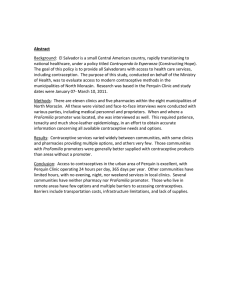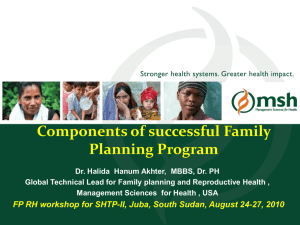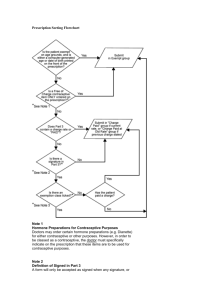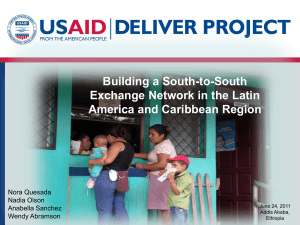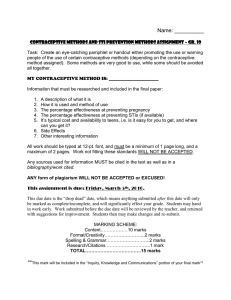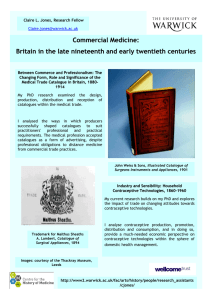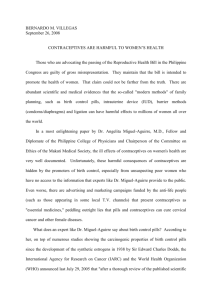Contraceptive Security Indicators 2015 Summary Findings
advertisement
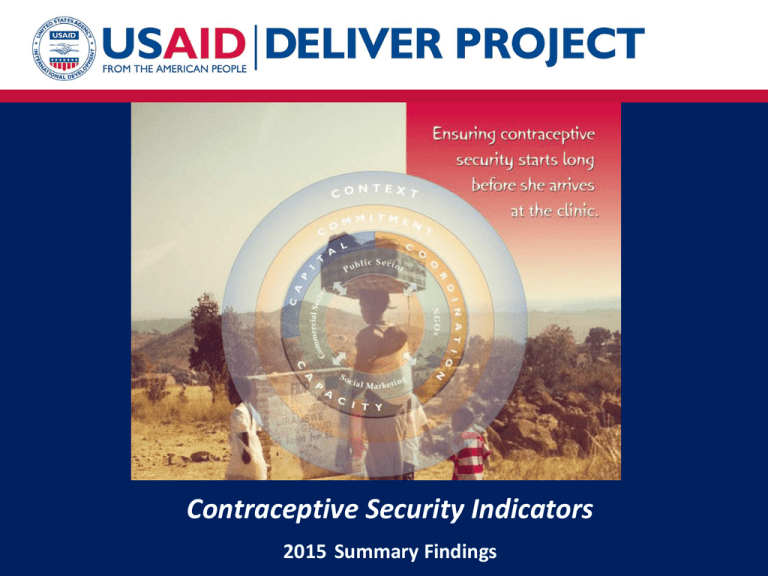
Contraceptive Security Indicators 2015 Summary Findings USAID | DELIVER PROJECT, Task Order 4 The USAID | DELIVER PROJECT, Task Order 4, is funded by the U.S. Agency for International Development (USAID) under contract number GPO-I-00-06-00007-00, order number AID-OAA-TO-10-00064, beginning September 30, 2010. Task Order 4 is implemented by John Snow, Inc., in collaboration with PATH; Crown Agents Consultancy, Inc.; Eastern and Southern African Management Institute; FHI360; Avenir Health; LLamasoft, Inc; The Manoff Group, Inc.; IMPERIAL Health Sciences; PRISMA; and VillageReach. The project improves essential health commodity supply chains by strengthening logistics management information systems, streamlining distribution systems, identifying financial resources for procurement and supply chain operation, and enhancing forecasting and procurement planning. The project encourages policymakers and donors to support logistics as a critical factor in the overall success of their healthcare mandates. Contents Defining CS SPARHCS 3 4 Finance Policies Commodities Coordination Supply Chain Conclusions 19 24 27 29 31 9 Overview of CS Indicators 5 Notes on the Data 6 Countries Surveyed 7 Key Findings 8 Contraceptive Security exists when every person is able to choose, obtain & use quality contraceptives whenever needed. Reproductive Health Commodity Security Framework The Contraceptive Security (CS) Indicators build on the Strategic Pathway to Reproductive Health Commodity Security (SPARHCS) framework. The framework is made up of components considered vital to achieving reproductive health commodity security (RHCS), often referred to as the 7 c’s– context, commitment, coordination, capital, capacity, client demand and utilization, and commodities. Overview of CS Indicators Who: What: Completed by key informants, survey data is used by country governments, policymakers, CS committees, advocates, program managers, donors and global partners. The survey covers 5 areas critical to CS: finance, policies, commodities, coordination and supply chain. When: Where: The survey is conducted annually and data has been collected since 2009. The 2015 survey collected data from 49 countries, primarily USAID | DELIVER PROJECT presence countries and USAID Tier 1 countries for population and reproductive health. Note: Finance responses reflect the most recently completed fiscal year and will vary by country. Why measure CS? Country stakeholders and advocates recognize the importance of monitoring country-level progress toward contraceptive security (CS) for advocacy, program planning, and monitoring purposes. Notes on the Data As a key informant survey, the questions have been designed to not require extensive background research. As with any key informant survey, the data are contingent on the knowledge of respondents. In some cases, precise data may be difficult for respondents to locate- particularly as relates to financing. Where responses are unknown, they have been removed from the denominator in calculating the percentages shown here. For questions regarding policies, the responses are intended to reflect official policy, which may vary from actual practice. See the data sheet for complete survey responses, including any clarifying comments. Countries Surveyed This slide deck presents data from 49 countries, collected through the CS Indicators Survey in 2015 during the 7th annual survey. Surveyed countries are shown in blue in the map below. These are primarily USAID | DELIVER PROJECT presence countries and USAID Tier 1 priority countries for Population and Reproductive Health. Key Findings Finance • 65% of countries used government funds for contraceptive procurement. • 15 countries indicated there was insufficient funding for contraceptives. Policies • 22 countries indicated insufficient funding for contraceptive procurement • On average, countries included 7 out of 9 methods on their National Essential Medicine List. • 45 countries reported having a contraceptive security strategy. Commodities • On average, countries offer 9 out of 11 methods in the public sector. • 92% of offer all 5 of the most frequently offered methods. • 85% of countries include CScountries in a national strategy Coordination •86% of countries have a committee that works on CS issues. •100% of committees have representatives from the Ministry of Health. • 91% of countries offer all five of the most commonly offered methods Supply Chain • 36% of countries had a central-level stockout at some point during the last year. • On average, these countries had central-level stockouts of 1-2 products . Finance for Procurement Indicators include: Sufficient financing from all sources is key to ensuring a reliable supply of contraceptives. Dollar value of estimated need for contraceptives to be procured for the public sector Existence of a government budget line item for contraceptives Amount of government funds allocated for contraceptives Government expenditures for contraceptive procurement Value of in-kind contraceptive donations for the public sector Value of Global Fund grants used for contraceptives (including condoms) Information on the existence of a funding gap Sources of Funding Government Funds Internally Generated Funds • Funds drawn from government revenue sources―usually from various taxes, duties or fees Other government funds • Basket Funds―pooled funds managed by the government which originate from various sources, including donors and the government • World Bank assistance―this funding (credits or loans) can be used for general budget support, sector budget support, or earmarked interventions • Other funds―include additional funds provided to the government by donors In-Kind Donations • Contraceptive supplies that donors provide to a government Global Fund Grants • These grants can be used to procure condoms or other contraceptives Tracking Financial Flows Government financing indicates a commitment to CS and also suggests sustainability. Tracking the financing process from the creation of a budget line item through funds being spent for procurement can help stakeholders identify financing bottlenecks. 60% Allocation of funds A budget line item does not always guarantee a funding commitment. 67% of countries allocated funds for contraceptive procurement. The group of countries allocating funds includes some countries without a line item. Also not all countries that included a line in the budget allocated funds. 67% Budget line item A dedicated line item for contraceptive procurement can help ensure that contraceptives are prioritized in annual budgeting. 60% countries surveyed in 2015 included a budget line item. 88% Funds spent on procurement Comparing funds spent to those allocated can help identify causes of funding issues. The majority of countries that allocated funds followed through with the procurement of commodities. Government Expenditures 58% of respondent countries indicated that government funds were spent on contraceptive procurement in the most recent complete fiscal year. On average, these countries spent $5.56 million on contraceptive procurement. Of those 28 countries: • 68% utilized internally generated funds • 11% used other government funds • 21% used some combination of both 21% Internally Generated Other government funds 11% 68% Internally generated & other government funds Cameroon Cote d’Ivoire Guinea Kenya Mali Mauritania Mozambique Niger Sierra Leone South Sudan Togo Afghanistan Armenia Georgia Pakistan Russia Yemen Haiti Latin America & the Caribbean Burundi Europe & Asia Of the 49 countries surveyed, 19 respondent countries did not spend government funds on contraceptive procurement during the previous fiscal year. Africa Government Expenditures Government Expenditures Africa Country Benin Burkina Faso Cape Verde DR Congo Ethiopia Ghana Madagascar Malawi Nigeria Rwanda Senegal South Africa Tanzania Uganda Zambia Zimbabwe Sixteen African countries reported utilizing government funds for contraceptive procurement. This information is reflected in the table below. Where known, government spending on contraceptives totaled $34,845,879. Of the government funds spent, the majority (75%) came from internally generated sources. South Africa reported covering 100% of contraceptive procurement with government funds. Total government spending Internally generated share of government spending $ $ $ $ $ $ $ $ $ $ $ 40,000 1,000,000 92,364 300,500 11,061,926 2,385,158 14,274 60,000 11,580,170 965,462 96,000 $ $ $ 937,576 5,600,000 712,449 Unknown 100% 100% 100% 100% 100% 0% 100% 100% 8% 100% 100% 100% 0% 11% 100% Unknown Internally generated funds Other government funds $ $ $ $ $ $ $ $ $ $ $ $ 40,000 1,000,000 92,364 300,500 14,274 60,000 980,170 965,462 96,000 600,000 712,449 Unknown $ $ 11,061,926 2,385,158 $ 10,600,000 $ $ Not applicable 937,576 5,000,000 Unknown Government Expenditures Europe & Asia Country Six out of twelve European and Asian countries surveyed utilized government funds for contraceptive procurement during the most recently completed fiscal year. This totaled more than one hundred million dollars ($101,000,033). As with the spending in African countries, the bulk of government funds were internally generated (83%). Two countries, India and Indonesia, comprise more than half ($62,620,880) of this spending. Total government spending Internally generated share of government spending $ 17,040,000 28% Internally generated funds Other government funds Bangladesh $ 4,810,000 $ India $ 27,000,000 $ 27,000,000 100% Indonesia $ 35,620,880 $ 35,620,880 100% Nepal $ 583,492 $ 686,461 85% Philippines $ 20,488,372 $ 20,488,372 100% Ukraine $ 135,376 $ 164,320 82% $ $ 12,230,000 102,969 28,944 Government Expenditures Latin America & Caribbean Country Dominican Republic El Salvador Guatemala Honduras Nicaragua Paraguay Peru Internally generated funds With the exception of Haiti, each of the surveyed countries from the LAC region used government funds for contraceptive procurement, totaling $14,502,068. Nearly all (98%) of this funding was internally generated. Other government funds Total government spending Internally generated share of government spending $ 1,340,000 $ 1,340,000 100% $ 1,700,000 $ 1,700,000 100% $ 903,535 $ 903,535 100% $ 1,279,865 $ 1,279,865 100% $ 979,470 $ 1,179,470 83% $ 1,923,556 $ 1,923,556 100% $ 6,175,642 $ 6,175,642 100% $ 200,000 Funding Sources In Africa, the majority of countries rely on in-kind donations for the bulk of their contraceptive financing. Five countries utilized Global Fund grants for the procurement of condoms, while Malawi use GF grants for both condoms and other contraceptives. In LAC, contraceptive financing is primarily done through internally generated funds, as most countries have graduated from donor assistance. Percentage of Total Spending for Public Sector Contraceptives, by Funding Source In-kind donations Internally Generated Funds Other government funds GF grant (condoms) GF grant (other contraceptive) 100% 90% 80% 70% 60% 50% 40% 30% 20% 10% Benin Burkina Faso Burundi Cameroon Cape Verde Cote dIvoire DR Congo Ethiopia Ghana Guinea Kenya Liberia Madagascar Malawi Mali Mauritania Mozambique Niger Nigeria Rwanda Senegal Sierra Leone South Africa South Sudan Tanzania Togo Uganda Zambia Zimbabwe Afghanistan Armenia Bangladesh Georgia India Indonesia Nepal Pakistan Philippines Russia Ukraine Yemen Dominican Republic El Salvador Guatemala Haiti Honduras Nicaragua Paraguay Peru 0% Africa Europe & Asia LAC Funding Gap To determine if funding was sufficient to meet the country’s needs, data on contraceptive financing was compared to the value of quantified need for the same time period. Where information was not available, respondents indicated if there was a funding gap. Many factors can result in a discrepancy between a quantified needs and funds spent, resulting in either a gap, or in funds exceeding the quantification projections. If a quantification did not accurately reflect the demand for contraceptive procurement, due to incorrect assumptions or poor data quality, then this figure does not reflect the true funding gap. Other factors that can impact the discrepancy between a quantification and expenditures, include different time frames, exchange rates, and changing costs of contraceptives. These factors can result either in a funding gap, or alternatively in the funding provided exceeding the projections from the quantification. Africa Europe & Asia LAC Peru Paraguay Nicaragua Honduras Haiti Guatemala El Salvador Dominican Republic Yemen Ukraine Philippines Pakistan Nepal Indonesia India Bangladesh Zimbabwe Zambia Uganda Togo Tanzania South Sudan Sierra Leone Senegal Rwanda Nigeria Niger Mozambique Mauritania Mali Malawi Madagascar Liberia Kenya Guinea Ghana Ethiopia Cote dIvoire Cape Verde Cameroon • Burundi 505% 74% 98% 100% 100% 91% 95% 160% 126% 79% 96% 100% 115% 105% 99% 97% 100% 80% 100% 43% 149% 119% 299% 123% 101% 72% 100% 95% 100% 97% 68% 80% 131% 10% 87% 100% 100% 38% 100% 150% 100% 100% 100% • Burkina Faso 20% Benin Funding Gap 15 countries indicated there was a funding gap. On average in countries with a gap, 80% of quantified need was funded. 12 countries indicated that contraceptive spending exceeded the amount identified through the quantification. 100% Percentage of Quantified Need Covered 80% 60% 40% 0% Policies Indicators include: Policies can reflect the level of government commitment to contraceptive security, as well as significantly impact client access to family planning. Existence of a national contraceptive security strategy Policies limiting or promoting access to family planning Inclusion of contraceptives on the National Essential Medicines List (NEML) Inclusion of CS concepts and family planning indicators in the Poverty Reduction Strategy Paper (PRSP) Which method is the lowest level provider allowed to dispense (task shifting)? Government Strategies Political support in the form of actionable government strategies is key to ensuring CS. These strategies may be standalone, or part of larger strategic plans. The CS Indicators Survey captures information on Poverty Reduction Strategy Papers as well as other strategies dedicated to or including CS. 37 countries included in the survey have a Poverty Reduction Strategy Paper (PRSP). While only 16% explicitly refer to CS, 76% prioritize reproductive health or family planning. 45 out of 49 countries reported having a contraceptive security strategy (or another strategy that includes a CS component). Where strategies exist, • 93% have been formally approved by the Ministry of Health. • 98% of countries report that the strategy is being implemented. National Essential Medicines List (NEML) Inclusion on the NEML can help prioritize methods offered and procured for the public sector. On average, countries include 7 out of 9 surveyed methods on the NEML or equivalent. Methods Offered in the Public Sector, Included in the NEML Combined oral contraceptives 100% 96% 100% Male condoms 88% 98% Intrauterine devices 88% 96% Injectables 90% 81% Progestin-only pills 86% 83% Implants 77% 58% Female condoms 63% Emergency contraceptive pills CycleBeads Public Sector 56% 65% 46% 21% National Essential Medicines List Provision & Access Taxes, duties and fees 33 countries report there are taxes, import duties, or fees on contraceptives– primarily affecting commercial-sector goods. Advertising bans 6 countries report advertising bans that affect the provision of private-sector contraceptives. Policies enabling the private sector 33 countries report policies that enable the private sector to provide contraceptive methods. Restricting access to sub-populations 5 countries report policies that restrict access to contraceptives for unmarried people. 6 countries report policies that restrict access to contraceptives for youth. • In each case, 3 countries are implementing the policy. Charges to clients In 15 countries there are charges to public-sector clients for FP services or commodities. • In 5 countries there are no exemptions for those clients who cannot pay. Charges to Clients Charges for Services Commodities A key component of family planning availability is affordability of services and/or supplies. In the CS Indicators Survey, countries report on formal policies regarding charges to clients for services or commodities. Cameroon Benin Cote d'Ivoire* Burkina Faso DR Congo* Cameroon Ghana Cape Verde * In total, 15 countries charge clients for family planning services or commodities. Seven of these countries charge for both services and commodities. Guinea* Cote d'Ivoire* Haiti* DR Congo* Indonesia* Mali* Ten countries have exemptions for those who cannot afford to pay, including five of the seven countries that charge for both. Mali* Pakistan* Senegal* Senegal* Togo Togo Zimbabwe* Zimbabwe* An asterisk* indicates that there are exemptions for those who are unable to pay. Commodities Providing a mix of contraceptive methods is essential to ensure that clients can choose the contraceptive that best fits their needs. Indicators include: Range of contraceptives offered through: • Public sector facilities • Nongovernmental organization (NGO) facilities • Social marketing • Commercial-sector facilities Methods included in the survey: • Male condoms • Female condoms • Combined oral contraceptives • Progestin-only pills • Intrauterine Device (IUD) • Injectables • Implants • Emergency Contraceptives • CycleBeads • Tubal ligation • Vasectomy Methods Offered by Sector Having methods available in a variety of sectors increases client access and helps promote equity. However, some contraceptive methods are more likely to be found in certain sectors. For example: emergency contraceptives and progestin only pills are more likely to be offered through private-sector facilities than through any other sector. They may, therefore, be accessible to fewer people than if they were also widely offered through the public sector or other sectors. Long-acting, permanent methods (LA/PM) are most commonly offered through the public sector. Public Sector Commercial Sector 100% 90% Social Marketing 80% NGO 70% 60% 50% 40% 30% 20% 10% 0% Combined oral Progestin-only contraceptives pills Injectables Implants IUDs Male condoms Female condoms Emergency LA/PM males LA/PM females CycleBeads contraceptive pills Method Availability 9 9 92% On average, countries offer 9 out of 11 assessed methods in the public sector 9 surveyed countries offer all 11 methods. 92% of countries offer all 5 of the most commonly offered methods: male condoms combined oral contraceptives IUDs tubal ligations injectables Burundi, DR Congo, Ghana, Guinea, Haiti, Kenya, Malawi, Senegal, and Togo Coordination & Leadership For CS to be realized, stakeholders from various sectors― public, NGO, social marketing and commercial―must work together to ensure access to contraceptives for all segments of the population. Indicators include: Existence of a national committee that works on contraceptive security • Organizations represented on the committee • Frequency of committee meetings • Legal status of the committee • Existence of a contraceptive security champion CS Committee 86% of countries have a committee that works on contraceptive security. While the membership varies by country, the Ministry of Health is represented on each country’s committee. 52% of the committees have legal status. 64% of committees met 3 or more times in the past year. Percentage of Contraceptive Security Committees that Include Specific Organizations 100% 98% 93% 88% 88% 85% 43% Ministry of Health units UN agencies NGOs Donors Central Medical Social marketing Commercial Store or Central organizations sector Warehouse organizations 40% Ministry of Finance or Ministry of Planning Supply Chain Indicators include: An effective supply chain enables the continuous availability of highquality contraceptives, which is essential to ensuring contraceptive security. Central-level stockout data Whether stockouts are a major problem at the central level Whether stockouts are a major problem at the service delivery point (SDP) level Central-level stockouts 60% of countries identified service delivery point stockouts as a large problem. 28% of countries identified central-level stockouts as a large problem. It should be noted that these indicators are more subjective than others. Central level stockouts are problematic, but do not always result in a stockout at lower levels of the system, and may not impact product availability for clients. CycleBeads 36% (16 of 45) of responding countries reported a central-level stockout of at least one contraceptive method during the last year--on average of 1-2 products. 5 Emergency contraceptive pills Stockouts reported during the year 14 6 Female condoms No stockouts reported during the year 20 7 Progestin-only pills 22 8 Implants 27 9 Injectables 31 11 Male condoms 32 7 IUDs 36 8 Combined oral contraceptives 37 9 0 5 36 10 15 20 25 Number of Countries 30 35 40 45 Conclusions What’s working More than 50% of governments are using their funds for contraceptives. 7 out of 9 methods on average are included on the National Essential Medicine List. Countries offer an average of 9 methods in the public sector. 86% of countries have a committee that works on CS issues. Fewer than 50% of countries experienced a central level stockout. Continue to expand range of commodities offered in all sectors. Diversify committee membership and increase frequency of meetings. Monitor stock at all levels of the system to ensure central level stockouts do not result in stockouts for clients at SDPs. What can improve? Increase number of countries allocating funds and following through to spend them Ensure that policies enable all sectors to offer a range of methods and all clients can access those methods. For more information Data Maps Dashboards USAID | DELIVER PROJECT Visit: http://deliver.jsi.com/dhome/whatwedo/commsecu rity/csmeasuring/csindicators There you’ll find: Data sheets for each year of data collection (2009 on) with all of the responses for each surveyed country, blank surveys, and frequently asked questions/survey tips Data dashboards by country (these also have the country’s responses from all survey years), region, and a global snapshot Briefs and papers Presentations Interactive maps displaying some indicator data the last mile @deliverproject
